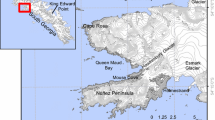Abstract
The Perote deer mouse Peromyscus bullatus is a rare species known only from a few specimens. It is endemic to the plains surrounding the Oriental Basin in the states of Veracruz and Puebla, Mexico, in the area where the Sierra Madre Oriental and the eastern end of the Transverse Volcanic Range merge. In past studies, a small area within the basin provided the only known habitat. During two recent surveys adjacent to this area, in habitats that matched the area in the state of Puebla where P. bullatus was previously found, we made new surveys. This mouse is differentiable from other species of the genus, mainly in the large of the auditory and the size of the ear. Intrinsic factors are highly discriminating in choice of habitat, low densities, and has restricted distribution, as well as the extrinsic factor of habitat deterioration, indicates a serious conservation problem.
Similar content being viewed by others
References
R. Alvarez F. González-Medrano (1972) ArticleTitleLa vegetación de la zona árida de Veracruz. Anales del Instituto de Biología Serie Botánica 43 77–100
H.T. Arita (1993) Riqueza de especies de la mastofauna de México R.A. Medellín G. Ceballos (Eds) Avances en el estudio de los mamíferos de México Asociación Mexicana de Mastozoología México 109–118
Burt W.H. 1960. Bacula of North American mammals, Vol. 113. Miscellaneous Publication, Museum of Zoology, University of Michigan, pp. 1–76.
Carleton M.D. 1989. Systematics and evolution. In: Kirkland G.L. and Layne J. (eds), in Advances in the Study of Peromyscus (Rodentia). Texas Tech University Press, pp. 7–141.
G. Ceballos P. Rodríguez (1993) Diversidad y conservación de los mamíferos de México. II. Patrones de endemicidad R.A. Medellín G. Ceballos (Eds) Avances en el estudio de los mamíferos de México Asociación Mexicana de Mastozoología México 87–108
S. Gaona (1997) Variación no geográfica de Peromyscus difficilis (Rodentia: Muridae) en la región noroeste de la Cuenca de Oriental en Puebla y Veracruz, México J. Arroyo Cabrales O.J. Polaco (Eds) Homenaje al profesor Ticul Álvarez. Colección Científica Colección Científica, Instituto Nacional de Antropología e Historia México 135–156
A.P. Gómez (1978) La Vegetación de Veracruz Compañía Editorial Continental México 93
Hall E.R. and Dalquest W.W. 1963. The Mammals of Veracruz, Vol. 14. University of Kansas Publication, Museum of Natural History, pp. 165–362.
D.F. Hoffmeister (1951) ArticleTitleA taxonomic and evolutionary study of the piñon mouse Peromyscus truei Illinois, Biological Monograph 21 1–104
Hooper E.T. 1957. Dental Patterns in Mice of the Genus Peromyscus, Vol. 99. Miscellaneous Publications Museum of Zoology, University of Michigan, pp. 1–59.
W.H. Osgood (1904) ArticleTitleThirty new mice of the genus Peromyscus from Mexico and Guatemala Proceeding of the Biological Society of Washington 17 55–77
W.H. Osgood (1909) ArticleTitleRevision of the mice of the American genus Peromyscus North American Fauna 28 1–285 Occurrence Handle10.3996/nafa.28.0001
J. Ramírez-Pulido C. Müdespacher (1987) ArticleTitleEstado actual y perspectivas del conocimiento de los mamíferos de México Ciencia 38 49–67
J. Ramírez-Pulido A. Castro Campillo A. Salame-Méndez (2001) ArticleTitleLos Peromyscus (Rodentia: Muridae) en la colección de mamíferos de la Universidad Autónoma Metropolitana-Unidad Iztapalapa (UAMI) Acta Zoológica Mexicana (nueva serie) 83 83–114
M.C. Reyes (1979) Geología de la Cuenca de Oriental NumberInSeriesVol. 71 Colección Científica, Instituto Nacional de Antropología e Historia México 1–70
SEMARNAT. 2002. Norma oficial Mexicana NOM-059-ECOL-2001, Protección ambiental-Especies nativas de México de flora y fauna silvestres -Categorí as de riesgo y especificaciones para su inclusión, exclusión o cambio- Lista de especies en riesgo. Diario Official de la Nación, March 6, 2002, pp. 56–85.
InstitutionalAuthorNameStatgraphics (1997) Statistical Graphics SystemStatistical Graphics Corporation STSC, Inc. USA
J.R. Tamsitt (1958) ArticleTitleThe baculum of the Peromyscus truei species group Journal of Mammalogy 39 598–599
M. Valdéz G. Ceballos (1997) ArticleTitleConservation of endemic mammals of Mexico: the Perote ground squirrel (Spermophilus perotensis) Journal of Mammalogy 78 74–84
J.L. Vial (1962) ArticleTitleThe auditory bulla of Dipodomys deserti (Rodentia) and evidence of this adaptive significance Revista de Biología Tropical 10 11–18
B.A. Wilcox D.D. Murphy (1985) ArticleTitleConservation strategy: the effects of fragmentation on extinction American Naturalist 12 879–887
Author information
Authors and Affiliations
Corresponding author
Rights and permissions
About this article
Cite this article
González-Ruíz, N., Álvarez-CastaÑeda, S.T. & Álvarez, T. Distribution, Taxonomy, and Conservation Status of the Perote Mouse Peromyscus bullatus (Rodentia: Muridae) in México. Biodivers Conserv 14, 3423–3436 (2005). https://doi.org/10.1007/s10531-004-0548-8
Received:
Accepted:
Issue Date:
DOI: https://doi.org/10.1007/s10531-004-0548-8




